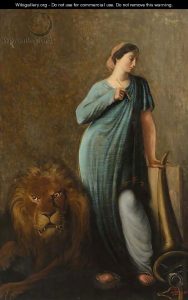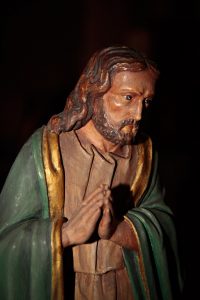What do Chicago, Clinton Township, Michigan, and Pembroke, Massachusetts have in common? They are all home to churches named for St. Thecla. Who was Thecla? 
The story of Thecla is found in the apocryphal book, The Acts of Paul and Thecla, written in the late second century. Church leader Tertullian, writing about 200 in de Baptismo 17, takes issue with the Acts in large part because of Thecla’s part in the tale and the apparent hold it had on contemporary women. In the story, attested in a number of early manuscripts (which helps demonstrate its popularity), Thecla hears Paul preaching in her home town of Iconium (today’s Konya in Turkey) and is converted. Thecla is engaged to be married at the time but, because of her conversion, decides not to go through with the marriage. Angered, her fiancé and her mother, Theocleia, set about trying to harm both Thecla and Paul. Despite their attempts – having Paul imprisoned, trying to have Thecla executed – their efforts are miraculously thwarted, and Paul escapes, taking Thecla with him to Antioch.
In Antioch, a man named Alexander falls in love with Thecla and tries to convince her to marry him. In rebuffing his advances, she rips his cloak and removes his crown from his head, thereby humiliating him. He brings Thecla before the governor, she confesses her actions toward Alexander, and the governor condemns her to fight the beasts in the arena. When she is brought before the beasts, however, the attempts to kill her are miraculously thwarted. Seeing a pit of water, she declares, “Now is the time for me to wash,” and throws herself into the water, thus baptizing herself. Despite the possibility that she might be devoured by the seals in the water, Thecla is again rescued time and again.
Thecla is supported by a powerful woman, Tryphaena; Thecla teaches her and her servants in the Christian faith and develops a following among women, who are converted and support her (Schneemelcher, 240-46). This aspect of the story in particular bothers Tertullian, according to Schneemelcher (214): in de Baptismo, he criticizes those women who cite the Acts of Paul as supporting the right of women to teach and baptize (further indication that women were in fact teaching and baptizing, contrary to the wishes of male church leaders).
Despite (or because of) Tertullian’s condemnation, Thecla emerged as a very popular figure and later a saint. In early Christian art, she is portrayed at least half a dozen times:
- A unique, unusual, and the earliest depiction of Thecla is a fragment of a gravestone or sarcophagus relief, dating from the late third or early fourth century. The carving shows a boat bearing the name “Thecla.” St. Paul guides the boat but the meaning is ambiguous: “Is Paul guiding Thecla, or is Thecla ‘carrying’ Paul by spreading his teaching on her apostolic mission?” (Cartlidge, 33)
- A fourth-century fresco in Ephesus shows Thecla’s mother, Theocleia, holding up a finger to berate St. Paul. The fresco is badly damaged, but to the right of this scene was probably also Thecla listening to Paul preach. (Cartlidge, 32)
- A fifth-century ivory tablet now in the British Museum in London shows Thecla in her home listening to Paul preach outside. (Cartlidge and Elliott, 145, 148)
- A fresco from the Christian necropolis at El Bagawat, Egypt, and dated to the fifth to seventh centuries shows a procession of virgins and St. Thecla burning at the stake. Thecla is miraculously saved when a hail-storm extinguishes the flames. (Cartlidge and Elliott, 37, 154)
- A fifth-to-eighth-century limestone roundel, perhaps originating in Egypt, shows the lion and lioness at Thecla’s feet, the part of the story in which, after traveling with Paul to Antioch, Thecla is condemned to death. The lioness “licks her feet and then helps defend her from the other animals sent in,” causing the onlooking women to be ecstatic. Two angels with wings also appear in the scene. (Cartlidge, 29, and Cartlidge and Elliott, 154-55)
- A fifth-century silver reliquary now in Adana, Turkey, bears a medallion in which are seated Peter and Paul face to face with a cross between them. Thecla stands in Orante position in one of two panels beside the medallion; the beasts are at her feet. (Cartlidge and Elliott, 150)
The frequency of Thecla’s appearance in early Christian art parallels her popularity throughout the Mediterranean as revealed in archaeological, architectural and legendary witnesses.
In some ways, Thecla’s story is the one most closely tied to ancient goddesses. Cartlidge and Elliott quote Elizabeth Willis:
The development of the legends of Thecla in both rhetorical and iconic form was a result of a need to Christianize the popularity of the Cybele cult in Asia Minor and to satisfy or to fill the gap caused by a loss of the Mother Goddess brought about by a rejection of pagan religion necessitated by a person’s conversion.
It might also be said that the loss of the mother goddess was not only a result of conversion – actually, many Christians probably did not give up their old worship altogether in order to worship Christ – but rather of forced conversion at certain times and places. And perhaps this was not always an attempt to “[fill] a gap.” Rather, early Christians adopted Thecla as a parallel to the deities they were already worshipping. Thecla was the mother goddess, was Cybele for all intents and purposes, at least to some people in some communities.
Whether this appropriation of ancient goddess worship occurred voluntarily by women devotees or was imposed on them is an important question. In the end, pagan worshippers were used to having – and needed – a female deity, because it was she who brought forth life, who nurtured, who healed, who sustained all species. The new savior god, Jesus, had now been revealed. He resembled traditional male savior gods – Dionysos, Liber, Harpocrates. But he was not mother, any more than they were. Male gods could not give birth, could not provide rain for the crops; if they shed blood, they either killed others or were killed. 
On the other hand was the celibate servant Thecla. She took the lead: she baptized herself and was saved from all sorts of calamities. She was devoted to the savior god but was powerful in her own right, and she had a large following of devoted women. Both Jesus and Thecla thus held a place in the hearts and cult practices of not only many early Christians but today’s, too.
Resources
Abrahamsen, Valerie. “Female Imagery in Christian Apocryphal Art,” Journal of Higher Criticism, Vol. 12, No. 1 (Spring 2006) 1-16.
Cartlidge, David R. “Thecla: The Apostle Who Defied Women’s Destiny,” Bible Review, Vol. XX, No. 6 (December 2004) 24-33.
Cartlidge, David R. and J. Keith Elliott. Art and the Christian Apocrypha. London and New York: Routledge, 2001.
Schneemelcher, Wilhelm. “Acts of Paul,” in Wilhelm Schneemelcher, ed., New Testament Apocrypha. Vol. Two: Writings Relating to the Apostles: Apocalypses and Related Subjects, revised ed., 220-21. Cambridge: James Clarke and Co., Westminster/John Knox Press, 1992.
